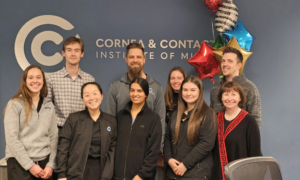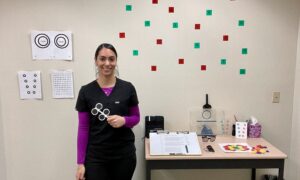By Munish Sharma, OD, MD, FAAO

July 26, 2017
Optometry schools are leading an effort to develop new models of inter-professional interaction right from the start of optometry school.
Increasingly, the practice of optometry is tied to the delivery of inter-professional care. Our future success depends on how we meet this challenge—and that effort begins at the start of optometric education1.
With the advent of the Affordable Care Act, and the ever-changing paradigm in health care delivery, optometry is required to adapt to changes and establish inter-professional sustainable relations to be part of patient-centered wellness teams. Care coordination under accountable care organizations and patient-centered medical homes require efficient means of communication and patient management.
Optometrists in various practice settings are already participating in inter-professional care intentionally or unintentionally. However, the best approach to inter-professional care adaptation begins with timely introduction early on as part of a well-structured curriculum around inter-professional education (IPE).
In many ways, optometry schools are leading this effort, as we develop new models of inter-professional interaction right from the start of optometry school.
In-depth, comprehensive planning processes are key to the development of a successful inter-professional curriculum. Another key element includes strong support from senior administration during the development process to manage logistics like resources and location; faculty time, workload and participation; curriculum mapping and student expectation.
At the Western University of Health Sciences (Western U), combined didactic lectures in pre-clinical topics like head and neck anatomy, inflammation, infectious diseases, etc., has been part of the curriculum from the beginning. A revamped IPE curriculum1 was developed in July 2007 by faculty representatives from all nine participating colleges in eight working committees. These recommendations were used by the implementation committee with help from the college deans and provost’s office to develop synchronized IPE for all participating colleges with common spring break, dedicated IPE day and time. Subsequently, a new Health Education Center building with dedicated IPE small meeting rooms was added in December 2009.
The ever-evolving IPE curriculum at Western U is based on a three-phase delivery model:
Phase I: During the first year, besides combined didactic courses, students from various colleges work on two realistic clinical case-based courses spanning almost half of the day in the week, where instead of focusing just on the clinical aspects, nontechnical competencies critical for all professions are developed. These competencies include communication, team formation, professional roles and responsibilities, a culture of safety, quality of life, and the ethical and legal environment of health care.
Phase II: During the second year, students are exposed to a TeamSTEPPS-based curriculum to practice teamwork in experimental settings in a series of online and face-to-face sessions. The Agency for Healthcare Research and Quality (AHRQ) and the Department of Defense (DoD) have developed TeamSTEPPS, a teamwork system that offers a powerful solution to improving collaboration and communication within health care institutions.
Phase III: This is the clinical care portion of the IPE program where students are engaged in inter-professional care as an active participant in various inter-professional initiatives like the Western Diabetes Institute. Students get to participate with their faculty in care delivery in the patient-centered collaborative programs.
Western Diabetes Institute (WDI) is a perfect example of an integrated practice unit organized around patients with diabetes and related multi-morbidity (conditions, complications, and circumstances. WDI includes a dedicated team of experts representing a spectrum of disparate disciplines including endocrinologists, nephrologists, podiatrists, orthodontists, optometrists, dieticians, patient educator and physical therapists. They are all aligned to address the complex medical and social needs of each patient.
Inter-professional programs are growing.
Based on 2014 ASCO survey3, out of 21 optometry schools surveyed, 19 reported their institution participated in IPE activities, and 9 (AZCOPT, MCPHS, NECO, NSUOCO, PCO, SCO, SUNY, UABSO, WUCO) indicated IPE was a program requirement. There is increasing desire among optometry schools to develop IPE activities for their students.
The result: Most of the graduating ODs and increasing numbers of practicing ODs are prepared with a holistic view, comfortable with inter-professional methods of providing wellness to the patient as a whole.
ODs in all phases of practice must recognize the need, and prepare to embrace inter-professional wellness care, if optometry is to assume its deserved position in health care delivery. For an established practice, adding a new associate steeped in this approach can be a valued asset and a strong step in this direction.
 Munish Sharma, OD, MD, FAAO, is assistant professor at the College of Optometry at Western University of Health Sciences. To contact him: sharmam@westernu.edu.
Munish Sharma, OD, MD, FAAO, is assistant professor at the College of Optometry at Western University of Health Sciences. To contact him: sharmam@westernu.edu.
References
1. Thistlethwaite J. Interprofessional education: a review of context, learning and the research agenda. Med Educ. 2012 Jan;46(1):58-70.
2. Aston SJ, Rheault W, Arenson C, Tappert SK, Stoecker J, Orzoff J, Galitski H, Mackintosh S. Interprofessional education: a review and analysis of programs from three academic health centers. Acad Med. 2012 Jul;87(7):949-55. doi:10.1097/ACM.0b013e3182583374. PubMed PMID: 22622216.
3. Baker JL, Vitek MA. Interprofessional Education and Collaborative Patient Care at U.S. Schools and Colleges of Optometry: A Special Report. Optometric Education. 2015;40(2):72-76.



























